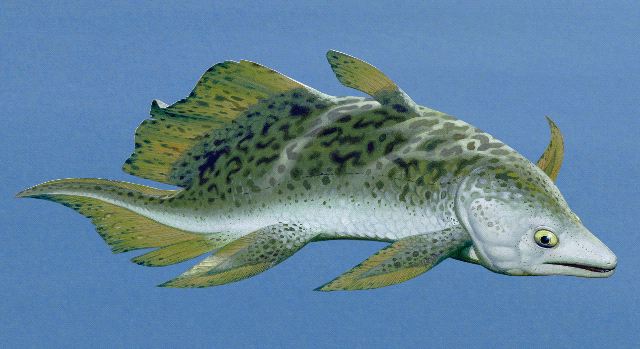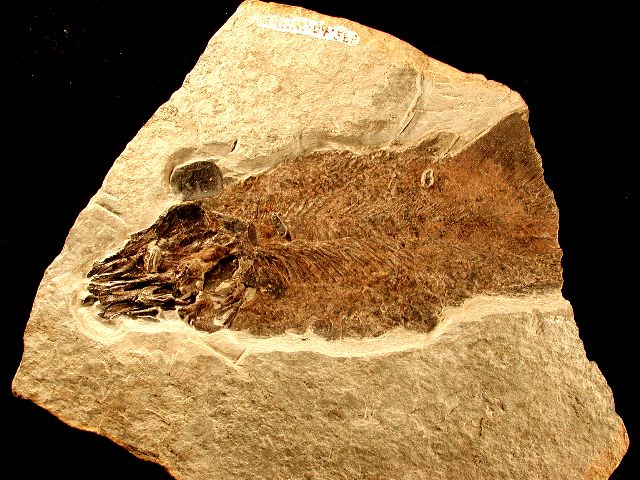Fleurantia
Just west of the main section of Miguasha’s fossil-rich cliff is an area known to local inhabitants as Pointe à Fleurant.
 (40 kb) It is from this place that the second dipnoan fish species found at Miguasha, Fleurantia denticulata, derives its name.
(40 kb) It is from this place that the second dipnoan fish species found at Miguasha, Fleurantia denticulata, derives its name.
Confused for several decades with specimens of Scaumenacia curta, this rare species was only properly identified in 1937. Despite their general similarity, certain features allow them to be distinguished fairly easily.

 (92 kb)The head of Fleurantia is more elongate, or more precisely, its snout is more slender. Its teeth were not completely fused to form dental plates, as in other dipnoi. Instead, specimens display conical denticles arranged in rows on the palate, hence the species name denticulata.
(92 kb)The head of Fleurantia is more elongate, or more precisely, its snout is more slender. Its teeth were not completely fused to form dental plates, as in other dipnoi. Instead, specimens display conical denticles arranged in rows on the palate, hence the species name denticulata.
Though it was as well equipped as Scaumenacia in terms of fins, Fleurantia’s epicercal tail was trinagular with a lower lobe pointed donwward, rather than being narrow and rounded. Its main dorsal fin was distinctively tall and upright. And the small grooves on its scales were straighter than the slightly sinuous grooves of Scaumenacia.

 (40 kb) It is from this place that the second dipnoan fish species found at Miguasha, Fleurantia denticulata, derives its name.
(40 kb) It is from this place that the second dipnoan fish species found at Miguasha, Fleurantia denticulata, derives its name.Confused for several decades with specimens of Scaumenacia curta, this rare species was only properly identified in 1937. Despite their general similarity, certain features allow them to be distinguished fairly easily.

 (92 kb)The head of Fleurantia is more elongate, or more precisely, its snout is more slender. Its teeth were not completely fused to form dental plates, as in other dipnoi. Instead, specimens display conical denticles arranged in rows on the palate, hence the species name denticulata.
(92 kb)The head of Fleurantia is more elongate, or more precisely, its snout is more slender. Its teeth were not completely fused to form dental plates, as in other dipnoi. Instead, specimens display conical denticles arranged in rows on the palate, hence the species name denticulata.Though it was as well equipped as Scaumenacia in terms of fins, Fleurantia’s epicercal tail was trinagular with a lower lobe pointed donwward, rather than being narrow and rounded. Its main dorsal fin was distinctively tall and upright. And the small grooves on its scales were straighter than the slightly sinuous grooves of Scaumenacia.
Site map | Feedback | Links | Sources | Credits
Fleurantia
<< Scaumenacia | Osteolepiforms >>




